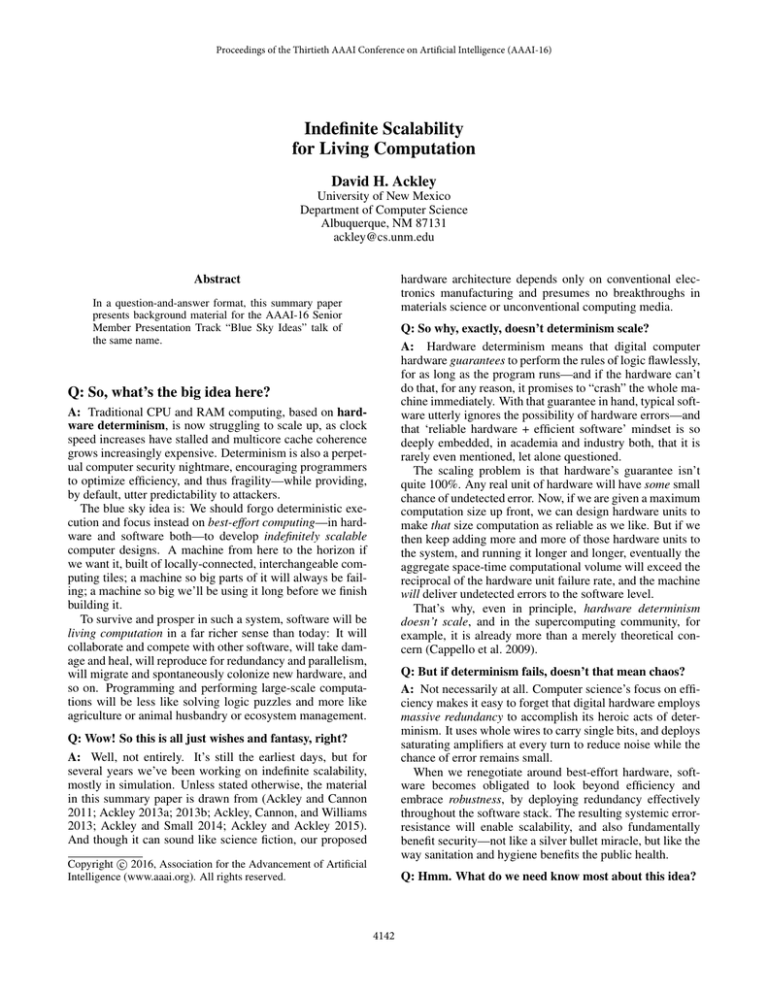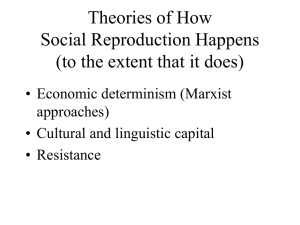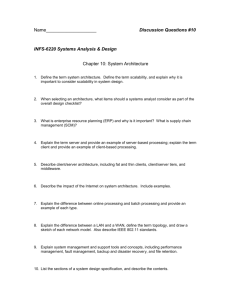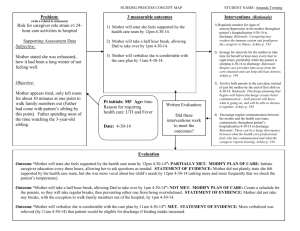
Proceedings of the Thirtieth AAAI Conference on Artificial Intelligence (AAAI-16)
Indefinite Scalability
for Living Computation
David H. Ackley
University of New Mexico
Department of Computer Science
Albuquerque, NM 87131
ackley@cs.unm.edu
hardware architecture depends only on conventional electronics manufacturing and presumes no breakthroughs in
materials science or unconventional computing media.
Abstract
In a question-and-answer format, this summary paper
presents background material for the AAAI-16 Senior
Member Presentation Track “Blue Sky Ideas” talk of
the same name.
Q: So why, exactly, doesn’t determinism scale?
A: Hardware determinism means that digital computer
hardware guarantees to perform the rules of logic flawlessly,
for as long as the program runs—and if the hardware can’t
do that, for any reason, it promises to “crash” the whole machine immediately. With that guarantee in hand, typical software utterly ignores the possibility of hardware errors—and
that ‘reliable hardware + efficient software’ mindset is so
deeply embedded, in academia and industry both, that it is
rarely even mentioned, let alone questioned.
The scaling problem is that hardware’s guarantee isn’t
quite 100%. Any real unit of hardware will have some small
chance of undetected error. Now, if we are given a maximum
computation size up front, we can design hardware units to
make that size computation as reliable as we like. But if we
then keep adding more and more of those hardware units to
the system, and running it longer and longer, eventually the
aggregate space-time computational volume will exceed the
reciprocal of the hardware unit failure rate, and the machine
will deliver undetected errors to the software level.
That’s why, even in principle, hardware determinism
doesn’t scale, and in the supercomputing community, for
example, it is already more than a merely theoretical concern (Cappello et al. 2009).
Q: So, what’s the big idea here?
A: Traditional CPU and RAM computing, based on hardware determinism, is now struggling to scale up, as clock
speed increases have stalled and multicore cache coherence
grows increasingly expensive. Determinism is also a perpetual computer security nightmare, encouraging programmers
to optimize efficiency, and thus fragility—while providing,
by default, utter predictability to attackers.
The blue sky idea is: We should forgo deterministic execution and focus instead on best-effort computing—in hardware and software both—to develop indefinitely scalable
computer designs. A machine from here to the horizon if
we want it, built of locally-connected, interchangeable computing tiles; a machine so big parts of it will always be failing; a machine so big we’ll be using it long before we finish
building it.
To survive and prosper in such a system, software will be
living computation in a far richer sense than today: It will
collaborate and compete with other software, will take damage and heal, will reproduce for redundancy and parallelism,
will migrate and spontaneously colonize new hardware, and
so on. Programming and performing large-scale computations will be less like solving logic puzzles and more like
agriculture or animal husbandry or ecosystem management.
Q: But if determinism fails, doesn’t that mean chaos?
A: Not necessarily at all. Computer science’s focus on efficiency makes it easy to forget that digital hardware employs
massive redundancy to accomplish its heroic acts of determinism. It uses whole wires to carry single bits, and deploys
saturating amplifiers at every turn to reduce noise while the
chance of error remains small.
When we renegotiate around best-effort hardware, software becomes obligated to look beyond efficiency and
embrace robustness, by deploying redundancy effectively
throughout the software stack. The resulting systemic errorresistance will enable scalability, and also fundamentally
benefit security—not like a silver bullet miracle, but like the
way sanitation and hygiene benefits the public health.
Q: Wow! So this is all just wishes and fantasy, right?
A: Well, not entirely. It’s still the earliest days, but for
several years we’ve been working on indefinite scalability,
mostly in simulation. Unless stated otherwise, the material
in this summary paper is drawn from (Ackley and Cannon
2011; Ackley 2013a; 2013b; Ackley, Cannon, and Williams
2013; Ackley and Small 2014; Ackley and Ackley 2015).
And though it can sound like science fiction, our proposed
c 2016, Association for the Advancement of Artificial
Copyright Intelligence (www.aaai.org). All rights reserved.
Q: Hmm. What do we need know most about this idea?
4142
A: Here are the bottom lines: This proposal represents a
huge but feasible change, and it is important for society and
long overdue, and it needs your help.
It’s built on three overlapping concepts—indefinite scalability for hardware and architecture, robust-first computing
for software and programming, and best-effort computing
for systems overall and models of computation.
In the rest of this paper, we will say a little more about
indefinite scalability in computer architecture, and then consider the particular approach to it we have been exploring,
which is called the Movable Feast Machine. We’ll show a
few simple examples to illustrate the ideas and the current
level of research and development, and conclude with a call
to action.
Q: What is indefinite scalability?
A: Indefinite scalability is a design principle saying that
any admissible computer architecture must be expandable
to arbitrary size without any fundamental re-engineering.
We may be unable to grow our indefinitely scalable machine
for external reasons—like we run out of money or real estate
or power or cooling—but never because we hit some internal design limit, like reaching the limits of a fixed-width
address or the light cone of a central clock.
Q: So, something like the internet?
A: No, as it is most commonly used, the Internet is only
finitely scalable, because its (IPv4 or v6) address space is
finite. The Internet could be indefinitely scalable, however,
via aggressive use of “anycasting” (Partridge, Mendez, and
Milliken 1993; Abley and Lindqvist 2006), which offers indefinite spatial scaling in exchange for a finite set of interprocessor request types.
Figure 1: The Movable Feast Machine (MFM) architectural
overview, with 2009-era prototype tile hardware at bottom.
(See text.)
2014, e.g.) do go beyond determinism—and some of them
could plausibly be cast into indefinitely scalable form.
In general, a design for an indefinitely scalable machine
amounts to a spatial tiling of hardware units, with additional
requirements as needed to preserve open-ended physical realizability. As an obvious example, fixed-latency global
communications is disallowed by the finite speed of light, as
are hierarchical or hypercube interconnects based on fixedlatency links. Less obviously, the presumption of a global
reset or “boot time” is also disallowed.
Q: But how can over 1038 IPv6 addresses not be enough?
A: Because for indefinite scalability, “really big” amounts
to “merely finite”: To preserve the clarity and power of
the idea, any appeals to practical sufficiency are irrelevant.
Moreover, anecdotally at least, it seems that every internal
limit in a design is a form of technical debt (Cunningham
1992; Allman 2012) that has consequences beyond the limit
itself. A design built on globally unique node names drawn
from a finite space, for example, incurs not only the risk of
name exhaustion, but all the issues and risks of centralized
naming and resolving, aliasing, spoofing, and so on. Indefinite scalability doesn’t automatically solve or avoid any such
issues, but it forces them all to the foreground; it helps keep
us honest and thereby provides a more stable basis for evaluating and choosing between architectures.
Q: It’s too hard! Is indefinite scalability really worth it?
A: It is hard, but the potential upside is computational systems of unlimited size, that are inherently tough, good at
their jobs, and hard to attack. In the end, hardware determinism is a property of small systems. Best-effort computing is
the future—it is what we should be optimizing, rather than
determinism. We are hurting ourselves by delaying.
Q: Well, if not the Internet, what is indefinitely scalable?
A: Good question! We’ll introduce our primary example,
the Movable Feast Machine, in a moment. A repurposed
“anycast-Internet,” as mentioned above, could be one example. And though cellular automata (CA) typically assume
deterministic execution and thus render themselves only
finitely scalable, probabilistic cellular automata (Grinstein,
Jayaprakash, and He 1985; Agapie, Andreica, and Giuclea
Q: What is the Movable Feast Machine?
A: The Movable Feast Machine is a tile-based indefinitely
scalable architecture (see Figure 1). Each tile is a small
von Neumann machine running an identical control program
out of non-volatile local memory. The program treats local
volatile memory as a patch of cellular automata grid, and
4143
ulam 1;
/** Fork bomb.
\symbol FB
\color #f00
\symmetries all
*/
element ForkBomb {
EventWindow ew;
Void behave() { ew[1] = ew[0]; }
}
Figure 3: A complete ulam element. Copies itself from the
event window center (ew[0]) to ew[1], which in this case
(due to the \symmetries all in the element metadata)
is an adjacent site chosen at random on each event.
Figure 2: The MFM per-tile event loop. (See text.)
performs events on randomly-chosen local grid sites, while
coordinating with adjacent tiles to seek consistent cache
views of their relevant grid sites. There are no global clocks
or synchronization barriers, and tiles race against each other
to acquire intertile locks for events that may affect caches.
The overall effect is of an asynchronous, probabilistic cellular automata, but one in which an individual grid site’s
neighborhood—which we call an event window—is huge
by CA standards, involving thousands of bits. As a result,
a traditional CA state transition lookup table is completely
infeasible; instead, a mostly-traditional serial deterministic
function is called to perform the state transition, depending
on the type bits in the event window’s center site. Figure 2
summarizes the tile event loop.
Q: But if a transition is deterministic, what’s the point?
A: That determinism only lasts as long as an event, which
is short, and can affect only its event window, which is tiny
by traditional programming standards. Although programming MFM element behavior functions is rather less obvious than classical serial programming, it is also much more
intuitive than composing typical CA rule tables, primarily
because execution is serial and effectively single-threaded
within an event, during which the event window acts like
passive memory. The corresponding challenges are that
event code cannot access persistent state outside the event
window or assume anything about event window contents
between invocations.
Figure 4: A Demon Horde Sort stochastic sorter. (See text.)
Q: That’s cute, but how do more complex things work?
A: In a general sense, building larger structures in the Movable Feast involves three aspects:
1. Functional: Programming more complex element behavior functions, and involving greater numbers of interacting element types,
2. Spatial: Deciding where to locate the involved atoms relative to each other, and if and how they should move, to
make possible local interactions that are useful within the
larger structures and purposes, and
Q: What does state transition code look like?
A: Over the last year and a half, we have developed a
programming language, called ulam, specifically to express
MFM state transitions. ulam has its own distinct flavors but
is deliberately designed to seem reasonably familiar to programmers used to conventional object-oriented procedural
languages. ulam compiles into C++, and from there via gcc
to machine code for dynamic loading into the simulation,
and we hope soon into live tile hardware as well. Figure 1
includes some legal but pointless ulam code, and Figure 3
presents a functional but complete lout of an element—a
ForkBomb that attempts to fill space with copies of itself,
with no regard for what might already be there: Hello World
and then some.
3. Temporal: Using spatial and functional mechanisms to
implement staged processes that unfold in time, such as
growth phases. Also, adjusting rate constants so some
subprocesses run much slower or faster than others. This
can enable programmers to use constant approximations
(if slower) or equilibrium approximations (if faster) to
simplify reasoning about otherwise complex dynamics.
Q: Well, maybe I asked for that. How about an example?
A: Figure 4 is a schematic representation of one of the earliest machines we investigated, called the Demon Horde Sort
4144
Figure 5: Six events in the life of a self-assembling four-port data switch, spreading over four simulated MFM tiles. Top left:
Initial state. Top center: After 100 average events per site (AEPS). Top right: After 1000 AEPS. Bottom left: After 2000 AEPS.
Bottom center: After three tiles are reset at 2500 AEPS. Bottom right: After 3000 AEPS. See text.
as an example of the temporal layering of dynamics: The
DReg operations are so slow compared to the Sorters that
the DReg can basically be ignored except when considering
the long-term dynamics of the system.
(DHS). Data atoms (blue), each holding a random 32 bit
number, are placed on the grid by the emitters (green) at the
right, and are carried right-to-left and moved up and down by
the Sorters (red), and eventually are extracted by absorbers
on the left (dark grey). The trick is, each Sorter remembers
the value of the last Data it moved, and when it considers
moving the next Data atom right-to-left, it also tries to move
it up or down based on the comparison of the current and
previous Data values.
The DHS illustrates all of the compositional mechanisms
just mentioned. By copying the Data value into the Sorter’s
internal storage, Data-Data comparisons can be performed
even when the Data items aren’t close enough to interact directly: The existence and behavior of the Sorters enable local interactions that advance the goals of the larger
structure. Similarly, by making basic spatial and geometric assumptions—that input is East, output is West, small
is North and large is South—the Sorters can autonomously
take actions that will help in the computation as a whole.
And finally, the “DReg” and “Res” in Figure 4 are part of
a “Dynamic Regulator” feedback system that maintains the
Sorter population at a reasonable density. Though the DReg
mechanism is interesting in its own right, here it just serves
Q: OK, but, how can the DHS possibly sort correctly?
A: It doesn’t. Its inherent resolution is determined by the
channel width, and its sorting quality generally improves
with increasing length/width aspect ratio. More basically,
though, in this problem formulation, correctness really isn’t
an option. Given that the emitters produce Data atoms intermittently and unpredictably, it’s not even well-defined what
the “correct” maximum value really is at any given moment.
Welcome to best-effort.
Q: I start to see.. Have you built other machines?
A: Certainly. As one last example, just briefly, Figure 5
shows six snapshots in the self-assembly of a toy four-port
data switch we have recently been exploring.
Starting from a single ‘switch wall’ atom, the switch
builds a box (blue outline), insulates it with passive Walls
(white) embedded with four I/O ports (red, yellow, green,
and blue line segments), and builds a routing grid (evenlyspaced white dots). The routing grid atoms observe nearby
4145
ports and then gossip among themselves to form gradients
to guide the data cells (scattered dots, colored to show their
destination port). Each data cell carries a 32 bit payload and
an eight bit sequence number, although this switch does not
attempt to perform packet reassembly.
After an average of one thousand events per site (1000
AEPS), the switch has completely self-assembled but still
has a backlog of data cells; by 2000 AEPS the switch is operating smoothly. Later, at 2500 AEPS, we severely damage
it by resetting three of the four underlying tiles, but it immediately begins to reassemble itself and, by 3000 AEPS, it is
almost healed.
Ackley, D. H.; Cannon, D. C.; and Williams, L. R. 2013.
A movable architecture for robust spatial computing. The
Computer Journal 56(12):1450–1468.
Ackley, D. H. 2013a. Bespoke physics for living technology.
Artificial Life 19(3 4):347–364.
Ackley, D. H. 2013b. Beyond efficiency. Commun. ACM
56(10):38–40. Author preprint: http://nm8.us/1.
Agapie, A.; Andreica, A.; and Giuclea, M. 2014. Probabilistic cellular automata. Journal of Computational Biology
21(9):699–708.
Allman, E. 2012. Managing technical debt. Queue
10(3):10:10–10:17.
Cappello, F.; Geist, A.; Gropp, B.; Kal, L. V.; Kramer, B.;
and Snir, M. 2009. Toward exascale resilience. IJHPCA
23(4):374–388.
Cunningham, W. 1992. The WyCash Portfolio Management System. In Addendum to the Proceedings on Objectoriented Programming Systems, Languages, and Applications (Addendum), OOPSLA ’92, 29–30. New York, NY,
USA: ACM.
Grinstein, G.; Jayaprakash, C.; and He, Y. 1985. Statistical mechanics of probabilistic cellular automata. Phys. Rev.
Lett. 55:2527–2530.
Partridge, C.; Mendez, T.; and Milliken, W. 1993. Host
Anycasting Service. RFC 1546 (Informational).
von Neumann, J. 1951. The general and logical theory of automata. In Jeffress, L. A., ed., Cerebral Mechanisms in Behaviour: the Hixon Symposium (1948). Wiley. 15–19. Also
appears as pages 302–306 in A.H. Taub, editor, John von
Neumann Collected Works: Volume V – Design of Computers, Theory of Automata and Numerical Analysis, Pergamon
Press, 1963.
Q: Very cool! But, how does all this affect AI?
A: Traditional computing is about constructing things once
and then trusting them to remain intact indefinitely. That’s
why it’s, at once, so marvelously efficient and so deathly
fragile. Robust-first computing, on the other hand, is about
continuous self-construction and maintenance, so that information structures are automatically refreshed as needed, or
at some rate, or both.
Sixty-five years ago, von Neumann (1951) predicted that
hardware determinism would soon be supplanted, but with
design lock-in and network effects it remains virtually unchallenged today. In AI’s long-running cross-pollination, let
us call it, between the neats and the scruffies, that dominance has given the neats sole possession of the home court
advantage—deterministic execution—without anybody really calling them on it. But now the costs of playing on that
court are rising too high.
It’s time for the neats to try playing an away game.
Q: Last question! I hate to ask, but who funds this work?
A: Eventually, a substantial research and development effort, performed and supported by many people and organizations, will be needed to develop the science and engineering
of best-effort computing. Perhaps you will be part of that.
For these early stages, support has come from a brave and
visionary few. The work summarized here was supported
in part by a Google Faculty Research Award, and in part by
grant VSUNM201401 from VanDyke Software.
References
Abley, J., and Lindqvist, K. 2006. Operation of Anycast
Services. RFC 4786 (Best Current Practice).
Ackley, D. H., and Ackley, E. S. 2015. Artificial life programming in the robust-first attractor. In Proc. of the European Conference on Artificial Life (ECAL).
Ackley, D. H., and Cannon, D. C. 2011. Pursue robust
indefinite scalability. In Proc. HotOS XIII. Napa Valley,
California, USA: USENIX Association.
Ackley, D. H., and Small, T. R. 2014. Indefinitely Scalable
Computing = Artificial Life Engineering. In Proceedings of
The Fourteenth International Conference on the Synthesis
and Simulation of Living Systems (ALIFE 14) 2014, 606–
613. MIT Press.
4146






